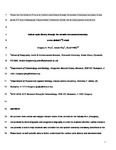Carbon cycle history through the Jurassic–Cretaceous boundary: A new global δ13C stack
| dc.contributor.author | Watanabe, Sayaka | |
| dc.contributor.author | Főzy, I | |
| dc.contributor.author | Pálfy, J | |
| dc.date.accessioned | 2016-04-14T12:11:30Z | |
| dc.date.accessioned | 2016-06-01T14:40:21Z | |
| dc.date.issued | 2016-06-01 | |
| dc.identifier.issn | 0031-0182 | |
| dc.identifier.issn | 1872-616X | |
| dc.identifier.other | C | |
| dc.identifier.uri | http://hdl.handle.net/10026.1/4782 | |
| dc.description | publisher: Elsevier articletitle: Carbon cycle history through the Jurassic–Cretaceous boundary: A new global δ13C stack journaltitle: Palaeogeography, Palaeoclimatology, Palaeoecology articlelink: http://dx.doi.org/10.1016/j.palaeo.2016.03.016 content_type: article copyright: Copyright © 2016 Published by Elsevier B.V. | |
| dc.description.abstract |
We present new carbon and oxygen isotope curves from sections in the Bakony Mts. (Hungary), constrained by biostratigraphy and magnetostratigraphy in order to evaluate whether carbon isotopes can provide a tool to help establish and correlate the last system boundary remaining undefined in the Phanerozoic as well provide data to better understand the carbon cycle history and environmental drivers during the Jurassic-Cretaceous interval. We observe a gentle decrease in carbon isotope values through the Late Jurassic. A pronounced shift to more positive carbon isotope values does not occur until the Valanginian, corresponding to the Weissert event. In order to place the newly obtained stable isotope data into a global context, we compiled 31 published and stratigraphically constrained carbon isotope records from the Pacific, Tethyan, Atlantic, and Boreal realms, to produce a new global δ13C stack for the Late Oxfordian through Early Hauterivian interval. Our new data from Hungary is consistent with the global δ13C stack. The stack reveals a steady but slow decrease in carbon isotope values until the Early Valanginian. In comparison, the Late Jurassic-Early Cretaceous δ13C curve in GTS 2012 shows no slope and little variation. Aside from the well-defined Valanginian positive excursion, chemostratigraphic correlation durSchning the Jurassic-Cretaceous boundary interval is difficult, due to relatively stable δ13C values, compounded by a slope which is too slight. There is no clear isotopic marker event for the system boundary. The long-term gradual change towards more negative carbon isotope values through the Jurassic-Cretaceous transition has previously been explained by increasingly oligotrophic condition and lessened primary production. However, this contradicts the reported increase in 87Sr/86Sr ratios suggesting intensification of weathering (and a decreasing contribution of non-radiogenic hydrothermal Sr) and presumably a concomitant rise in nutrient input into the oceans. The concomitant rise of modern phytoplankton groups (dinoflagellates and coccolithophores) would have also led to increased primary productivity, making the negative carbon isotope trend even more notable. We suggest that gradual oceanographic changes, more effective connections and mixing between the Tethys, Atlantic and Pacific Oceans, would have promoted a shift towards enhanced burial of isotopically heavy carbonate carbon and effective recycling of isotopically light organic matter. These processes account for the observed long-term trend, interrupted only by the Weissert event in the Valanginian. | |
| dc.format.extent | 46-61 | |
| dc.language | en | |
| dc.language.iso | en | |
| dc.publisher | Elsevier BV | |
| dc.relation.replaces | http://hdl.handle.net/10026.1/4501 | |
| dc.relation.replaces | 10026.1/4501 | |
| dc.subject | Late Jurassic | |
| dc.subject | Early Cretaceous | |
| dc.subject | Chemostratigraphy | |
| dc.subject | Carbonate carbon cycle history | |
| dc.title | Carbon cycle history through the Jurassic–Cretaceous boundary: A new global δ13C stack | |
| dc.type | journal-article | |
| dc.type | Journal Article | |
| plymouth.author-url | https://www.webofscience.com/api/gateway?GWVersion=2&SrcApp=PARTNER_APP&SrcAuth=LinksAMR&KeyUT=WOS:000375517800005&DestLinkType=FullRecord&DestApp=ALL_WOS&UsrCustomerID=11bb513d99f797142bcfeffcc58ea008 | |
| plymouth.volume | 451 | |
| plymouth.publication-status | Accepted | |
| plymouth.journal | Palaeogeography, Palaeoclimatology, Palaeoecology | |
| dc.identifier.doi | 10.1016/j.palaeo.2016.03.016 | |
| plymouth.organisational-group | /Plymouth | |
| plymouth.organisational-group | /Plymouth/Faculty of Science and Engineering | |
| plymouth.organisational-group | /Plymouth/Faculty of Science and Engineering/School of Geography, Earth and Environmental Sciences | |
| plymouth.organisational-group | /Plymouth/REF 2021 Researchers by UoA | |
| plymouth.organisational-group | /Plymouth/REF 2021 Researchers by UoA/UoA07 Earth Systems and Environmental Sciences | |
| plymouth.organisational-group | /Plymouth/Research Groups | |
| plymouth.organisational-group | /Plymouth/Research Groups/Marine Institute | |
| plymouth.organisational-group | /Plymouth/Users by role | |
| plymouth.organisational-group | /Plymouth/Users by role/Academics | |
| plymouth.organisational-group | /Plymouth/Users by role/Researchers in ResearchFish submission | |
| dcterms.dateAccepted | 2016-03-17 | |
| dc.rights.embargodate | 2017-3-19 | |
| dc.identifier.eissn | 1872-616X | |
| dc.rights.embargoperiod | 12 months | |
| rioxxterms.versionofrecord | 10.1016/j.palaeo.2016.03.016 | |
| rioxxterms.licenseref.uri | http://www.rioxx.net/licenses/under-embargo-all-rights-reserved | |
| rioxxterms.licenseref.startdate | 2016-06-01 | |
| rioxxterms.type | Journal Article/Review |


